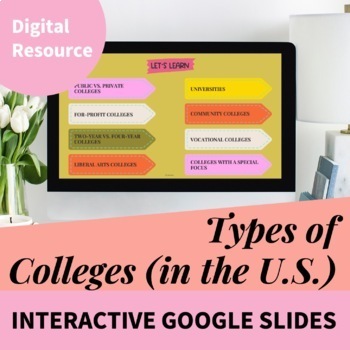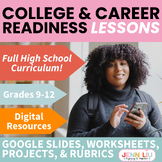Types of Colleges - College Readiness
- PDF
- Google Apps™

What educators are saying
Also included in
- Calling all high school AVID, Advisory, and college and career readiness teachers and counselors! Need help preparing your students for the college application and admission process? Save yourself time with these engaging NO-PREP Google Slides lessons, activities, worksheets, projects, and checklistPrice $97.20Original Price $121.50Save $24.30
- Attention all high school educators counseling or teaching in an AVID, Advisory, life skills, or other college and career readiness programs! If you're feeling a little lost or stressed coming up with lessons and activities for your college and career readiness curriculum, I got you!Save yourself prPrice $217.80Original Price $272.25Save $54.45
- Give your students a basic introduction to college using the three NO-PREP interactive Google Slides presentations in this bundle:1) Is College Worth It?2) Types of College Degrees3) Types of Colleges⭐️ Also includes a college terms word search!⭐️ You save 20% when you buy this bundle instead of purchPrice $15.40Original Price $19.25Save $3.85
Description
Want to help your high school students with college planning and improve their college readiness? Teach them about the different types of colleges in the U.S. with this digital resource -- an interactive Google Slides presentation. It's a complete lesson in one slide deck!
NOTE: I also have this same presentation with Pear Deck slides! Click here for the Pear Deck version.
⭐️ These slides introduce students to the different types of colleges, including public vs. private colleges, for-profit colleges, two- vs. four-year colleges, liberal arts colleges, universities, community colleges, vocational-technical colleges, and colleges with a special focus (e.g., HBCUs, HSIs, and TCUs).
WHAT'S INCLUDED (a complete lesson that uses the 5E Learning Cycle!):
- Engage: Question to hook students.
- Explore: Question to activate prior knowledge and the chance to ask questions before getting into the lesson.
- Explain: An overview of 10 different types of colleges.
- Elaborate/Extend: The extension part of the lesson includes discussion questions and an editable assignment asking students to find a college for five of the categories, the average annual cost with and without financial aid, and the average retention and graduation rates, and then to make a chart/table to show their findings. (Note: this is the only editable part of the presentation so that you can change the extension activity as you see fit; other ideas are included!).
- Evaluate: Reflection questions at the end of the presentation.
- Extra: Ideas for engaging students and extending the lesson further!
⭐️ This presentation can be used by teachers or counselors with distance learning, face-to-face instruction, OR a hybrid approach in any secondary class. You can present the lesson to the whole class or have students review it themselves independently or in small groups! This is the perfect lesson for a high school AVID, advisory, or language arts class!
⭐️ This product is a COMPLETE LESSON in one place (similar to a Hyperdoc, which takes students through the learning cycle in one doc or slide deck using hyperlinks and other media). Perfect for using as a differentiated, self-paced, student-centered lesson, and/or whole class presentation!
⭐️ The time it takes for the entire lesson will vary depending on how much time you allow for group discussions, follow-up class sharing, and extension activities. You could spend as little as 45 minutes on the presentation itself, if that's all the time you have, or one to three whole classes or more if you include some of the suggested extension activities. For ESL classes, you may need a little need more time.
⭐️ This lesson is also included in my College Readiness Bundle and my College and Career Readiness BUNDLE.
⭐️ You may also like Types of College Degrees.
Note: You can skip or delete any of the slides you don't want to use and add your own notes to any of the slides.
This lesson has it all:
-Explicit instruction
-21st century skills
-Multi-modalities
-Hands-on learning
-Differentiation
-Scaffolding
-Higher levels of questioning
-Real-life connection
-Student choice
IF YOU LIKE THIS PRODUCT AFTER PURCHASING IT, PLEASE GO TO YOUR TPT PURCHASES AND LEAVE ME A REVIEW AND EARN TPT CREDITS! AND BE SURE TO FOLLOW ME ON TPT FOR UPDATES ON NEW PRODUCTS!
CREDITS: Grade Onederful, Kaitlynn Albanni, Bricks and Border
⭐️ Get this FREE College and Career Readiness Curriculum Planning Guide on my website! Click HERE.
⭐️ Learn more about me on my website engagingtoempower.com and get some FREE resources!
⭐️ Get in touch by using this form HERE.
⭐️ Check out my other products on TPT and find out when I make new products (be sure to follow!): Jenn Liu: Engaging to Empower
Aloha,
Jenn
Copyright © Jenn Liu
Permission to use for single classroom use only.
Please purchase additional licenses if you plan to share this product with other teachers.








